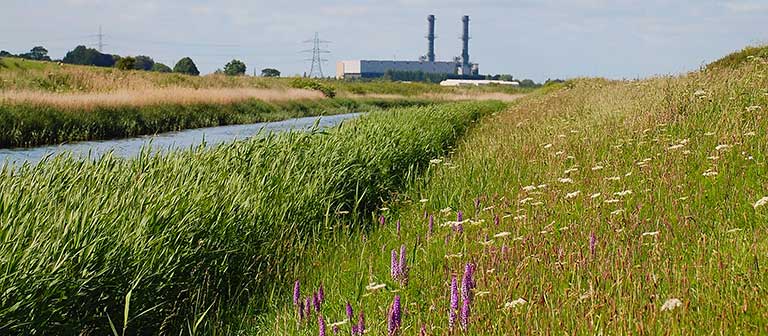The Environment Act 2021: Impacts and Opportunities

The long-awaited Environment Act 2021 received royal assent on 9 November 2021 and includes a number of impacts and opportunities for flood risk management authorities (RMAs) in England, including internal drainage boards (IDBs).
Much of the Act now requires regulations to be developed and consulted upon to define the details and to set a date from when the provisions will come into force. ADA has undertaken a full analysis of the Act focusing on its implications for IDBs. A Technical Note has been shared with ADA’s members.
Below is a summary of the key topics for RMAs within the new Act covered by the analysis:
Office for Environmental Protection (OEP)
This new public body has been formed to strengthen environmental accountability by holding government and public authorities to account, and to monitor the Government’s progress towards their environmental improvement targets. Members of the public are able to submit complaints online to the OEP concerning alleged failures by public authorities to comply with environmental law.
Land valuation for the purposes of calculating land drainage charges
The Act has provided for changes to be made to modernise the way that land is valued for the purpose of apportioning the costs of IDBs and calculating drainage rates and special levies. This is a change IDBs have called for and ADA has supported.
Local Nature Recovery Strategies
Local Nature Recovery Strategies (LNRS) will be spatial strategies for nature which will plan, map, and agree priorities for nature’s recovery in a given area. LNRS are expected to be led mainly by local authorities but developed and delivered in partnership with a wide range of local stakeholders, including IDBs.
Biodiversity Assessment and Reporting
Pubic Authorities are required to actively carry out strategic assessments of the actions they can take to enhance and conserve biodiversity, and then take that action. IDBs already do this through their respective Biodiversity Action Plans.
Species Conservation Strategies and Protected Sites Strategies
Public authorities will be expected to cooperate with Natural England in the development and implementation of Protected Site Strategies, and Species Conservation Strategies where they relate to areas under their management (e.g. a SSSI within an internal drainage district), and must have regard for them whilst undertaking their functions.
Biodiversity Net Gain
Where an authority is planning development which will require planning permission, they will be subject to the new biodiversity net gain rules from 2023 including the management of the site to deliver the required outcomes for at least 30 years following project completion. RMAs should also prepare to assess biodiversity gain plans through their consenting functions.
Abstraction
Changes will give the Environment Agency the ability to: revise an abstraction licence to reflect the volume of water that has historically been used, and to revoke a license, if it is deemed that the revision is necessary to protect the environment. IDBs may need to adjust water levels in the future to assist land managers adapting to the consequences of these changes.
Waste and resource efficiency
Changes will extend producer responsibility for the cost of disposal of products, starting with plastic packaging and require waste to be sorted into and collected separately in waste “streams” that separate out recyclable materials.
Collaborative water resource planning
Regional Water Resource Management Plans aim to address the balance of water supply and demand. RMAs should actively engage with their local water resource planning partnership in order to put forward their case and contributions to the development of the catchment approach to water resource management.
Conservation covenants
This will enable landowners to enter into a voluntary but legally binding agreement to assign a particular piece of land to be managed for conservation and the public good. There could be opportunities for local public bodies, such as IDBs, to assist with the management of such land.
Further Information
Environment Act 2021 [legislation.gov.uk]
ADA Technical Note – Environment Act 2021: Impact & Opportunities for IDBs
Press release: World-leading Environment Act becomes law [gov.uk]
Archive
- July 2025
- June 2025
- March 2025
- February 2025
- January 2025
- December 2024
- November 2024
- October 2024
- September 2024
- August 2024
- July 2024
- June 2024
- May 2024
- April 2024
- March 2024
- January 2024
- December 2023
- November 2023
- October 2023
- September 2023
- August 2023
- July 2023
- June 2023
- May 2023
- April 2023
- March 2023
- February 2023
- January 2023
- December 2022
- September 2022
- August 2022
- July 2022
- June 2022
- May 2022
- April 2022
- March 2022
- February 2022
- January 2022
- December 2021
- November 2021
- September 2021
- July 2021
- May 2021
- March 2021
- February 2021
- January 2021
- December 2020
- November 2020
- October 2020
- September 2020
- August 2020
- July 2020
- May 2020
- April 2020
- March 2020
- February 2020
- January 2020
- December 2019
- November 2019
- October 2019
- September 2019
- August 2019
- July 2019
- June 2019
- May 2019
- April 2019
- March 2019
- February 2019
- January 2019
- December 2018
- November 2018
- October 2018
- September 2018
- August 2018
- July 2018
- June 2018
- May 2018
- April 2018
- March 2018
- February 2018
- January 2018
- December 2017
- November 2017
- October 2017
- September 2017
- August 2017
- July 2017
- June 2017
- May 2017
- April 2017
- March 2017
- February 2017
- January 2017
- October 2016
- September 2016
- August 2016
- July 2016
- June 2016
- May 2016
- April 2016
- March 2016
- January 2016
